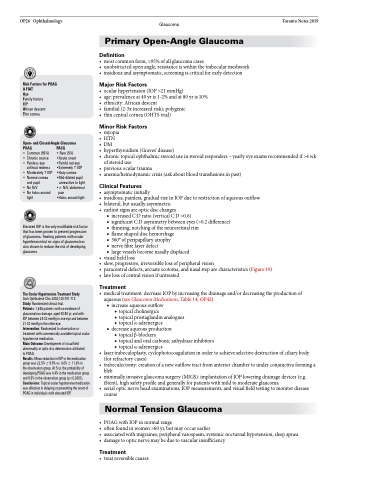Page 916 - TNFlipTest
P. 916
OP26 Ophthalmology
Glaucoma
Toronto Notes 2019
Risk Factors for POAG AFIAT
Age
Family history
IOP
African descent Thin cornea
Open- and Closed-Angle Glaucoma
Primary Open-Angle Glaucoma
Definition
• mostcommonform,>95%ofallglaucomacases
• unobstructedopenangle,resistanceiswithinthetrabecularmeshwork • insidiousandasymptomatic,screeningiscriticalforearlydetection
Major Risk Factors
• ocularhypertension(IOP>21mmHg)
• age:prevalenceat40yris1-2%andat80yris10% • ethnicity:Africandescent
• familial (2-3x increased risk); polygenic
• thincentralcornea(OHTStrial)
Minor Risk Factors
• myopia
• HTN
• DM
• hyperthyroidism(Graves’disease)
• chronictopicalophthalmicsteroiduseinsteroidresponders–yearlyeyeexamsrecommendedif>4wk
of steroid use
• previous ocular trauma
• anemia/hemodynamiccrisis(askaboutbloodtransfusionsinpast)
Clinical Features
• asymptomatic initially
• insidious, painless, gradual rise in IOP due to restriction of aqueous outflow • bilateral,butusuallyasymmetric
• earliestsignsareopticdiscchanges
■ increasedC:Dratio(verticalC:D>0.6)
■ significant C:D asymmetry between eyes (>0.2 difference) ■ thinning, notching of the neuroretinal rim
■ flame shaped disc hemorrhage
■ 360° of peripapillary atrophy
■ nerve fibre layer defect
■ large vessels become nasally displaced
• visualfieldloss
• slow,progressive,irreversiblelossofperipheralvision
• paracentraldefects,arcuatescotoma,andnasalsteparecharacteristics(Figure19) • latelossofcentralvisionifuntreated
Treatment
• medical treatment: decrease IOP by increasing the drainage and/or decreasing the production of aqueous (see Glaucoma Medications, Table 14, OP42)
■ increase aqueous outflow
◆ topical cholinergics
◆ topical prostaglandin analogues ◆ topical α-adrenergics
■ decrease aqueous production
◆ topical β-blockers
◆ topical and oral carbonic anhydrase inhibitors ◆ topical α-adrenergics
• laser trabeculoplasty, cyclophotocoagulation in order to achieve selective destruction of ciliary body (for refractory cases)
• trabeculectomy:creationofanewoutflowtractfromanteriorchambertounderconjunctivaforminga bleb
• minimallyinvasiveglaucomasurgery(MIGS):implantationofIOPloweringdrainagedevices(e.g. iStent), high safety profile and generally for patients with mild to moderate glaucoma
• serial optic nerve head examinations, IOP measurements, and visual field testing to monitor disease course
Normal Tension Glaucoma
• POAGwithIOPinnormalrange
• oftenfoundinwomen>60yr,butmayoccurearlier
• associatedwithmigraines,peripheralvasospasm,systemicnocturnalhypotension,sleepapnea • damagetoopticnervemaybeduetovascularinsufficiency
Treatment
• treatreversiblecauses
POAG
• Common (95%)
• Chronic course
• Painless eye
without redness
• Moderately IOP
• Normal cornea
and pupil
• No N/V
• No halos around light
PACG
• Rare (5%) •Acute onset •Painful red eye •Extremely IOP •Hazy cornea •Mid-dilated pupil
unreactive to light •± N/V, abdominal
pain
•Halos around light
Elevated IOP is the only modifiable risk factor that has been proven to prevent progression of glaucoma. Treating patients with ocular hypertension but no signs of glaucoma has also shown to reduce the risk of developing glaucoma
The Ocular Hypertension Treatment Study
Arch Ophthalmol-Chic 2002;120:701-713
Study: Randomized clinical trial.
Patients: 1,636 patients with no evidence of glaucomatous damage, aged 40-80 yr, and with IOP between 24-32 mmHg in one eye and between 21-32 mmHg in the other eye.
Intervention: Randomized to observation or treatment with commercially available topical ocular hypotensive medication.
Main Outcome: Development of visual field abnormality or optic disc deterioration attributed
to POAG.
Results: Mean reduction in IOP in the medication group was 22.5% ± 9.9% vs. 4.0% ± 11.6% in
the observation group. At 5 yr, the probability of developing POAG was 4.4% in the medication group and 9.5% in the observation group (p<0.0001). Conclusions: Topical ocular hypotensive medication was effective in delaying or preventing the onset of POAG in individuals with elevated IOP.


